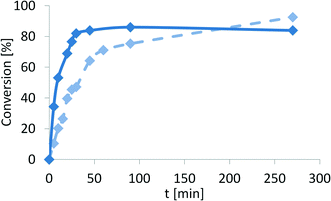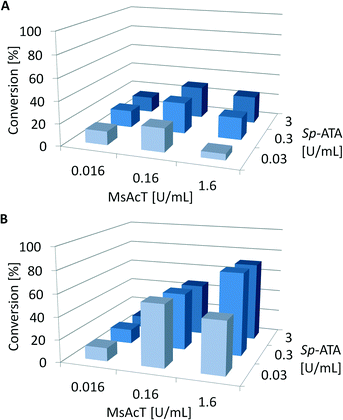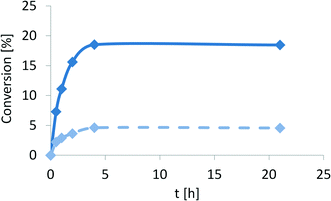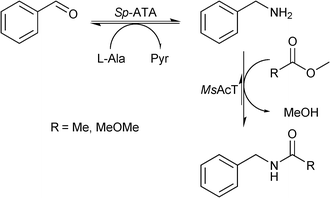 Open Access Article
Open Access ArticleCreative Commons Attribution 3.0 Unported Licence
One-pot biocatalytic amine transaminase/acyl transferase cascade for aqueous formation of amides from aldehydes or ketones†‡
Henrik
Land
,
Peter
Hendil-Forssell
,
Mats
Martinelle
and
Per
Berglund
*
KTH Royal Institute of Technology, Division of Industrial Biotechnology, School of Biotechnology, AlbaNova University Center, SE-106 91 Stockholm, Sweden. E-mail: per.berglund@biotech.kth.se
First published on 11th April 2016
Abstract
An efficient one-pot one-step biocatalytic amine transaminase/acyl transferase cascade for the formation of amides from the corresponding aldehydes and ketones in aqueous solution has been developed. N-Benzyl-2-methoxyacetamide has been synthesized utilizing the developed cascade with conversions up to 97%. The cascade was also evaluated for the synthesis of chiral amides.
Biocatalytic acylation/amidation is well-known and has been applied for decades1 but it has often been limited to the use of organic solvents to avoid hydrolysis. The acyl transferase from Mycobacterium smegmatis (MsAcT) is an enzyme that can perform trans-acylations in aqueous solution.2,3 Only a few hydrolases can catalyze trans-acylation in water4–8 and MsAcT also has the ability to act as a perhydrolase and catalyze the formation of peracids from esters.3 Since MsAcT can catalyze acylation for the formation of esters in aqueous solution we hypothesized that it could also utilize amines for amidation under the same conditions. Amidation should also in theory be able to reach higher conversions due to the higher nucleophilicity of the amine compared to the alcohol and the more stable amide product which would drive the equilibrium towards product formation.
Amine transaminases have been extensively studied during the last decades due to their ability to perform asymmetric synthesis of both chiral and achiral primary amines from the corresponding pro-chiral ketones or aldehydes with excellent yield and enantiomeric excess (ee).9,10 There are many examples of cascades involving amine transaminases and in most cases by-product removal to shift the unfavorable equilibrium towards amine synthesis is used.11–17 There are also recent reports of synthetic cascades where amine transaminases are involved in longer reactions sequences.18 There have however been fewer reports of amine transaminase cascades where the reductive amination is followed by amidation in a later stage of the cascade19 and it has never been performed in a one-pot one-step fashion where one-step means that the reaction is carried out in only one operational step even though the cascade contains several reaction steps working simultaneously. The amide is a common functional group in a wide variety of important compounds such as pharmaceuticals1,20,21 and polymers22 and an aqueous one-pot biocatalytic synthesis route starting from inexpensive aldehydes and ketones would be a cheap and green alternative to existing procedures. The irreversible nature of amide formation in these mild conditions and in the presence of the previously mentioned enzymes23 would also serve as efficient equilibrium displacement of the thermodynamically challenging reductive amination.
One theoretical drawback of a one-pot one-step amine transaminase/acyl transferase cascade is that the amine donor of the transamination will compete with the amine product in the second step of the cascade. This can however be circumvented when MsAcT is used since it does not accept amino acids as substrates for amidation (unpublished results). This opens up the possibility of using alanine as amine donor for the transamination step of the cascade since it is accepted by most amine transaminases. L-alanine (used in the case of an (S)-selective amine transaminase) is cheap and readily available. It also has a high solubility in water and can therefore be used in large excess to displace the equilibrium towards product formation.
Since there is a plethora of available amine transaminases that catalyze the desired reaction under a wide range of pH-values, the optimization of the cascade conditions was focused on MsAcT. The pH-optimum was investigated using a model reaction with benzylamine as acyl acceptor/nucleophile and methyl acetate as acyl donor forming the product N-benzylacetamide (Scheme 1, MsAcT catalyzed step). The optimal pH was found to be around pH 11 (Fig. S1, ESI‡). The reason for the high pH-optimum is believed to be due to the protonation state of benzylamine at higher pH-values (pKa = 9.34).24 There is however no known amine transaminase operating well at pH-values above 10 and therefore pH 10 was chosen for the continuation of the cascade optimization. One amine transaminase that is active at this alkaline pH is the amine transaminase from Silicibacter pomeroyi (Sp-ATA). It has a wide substrate scope and a pH-optimum of approximately 9.525 and was therefore chosen as the catalyst for the first step of the cascade.
With an established pH of the cascade, reactions could now be run and followed to see how far the reaction could proceed. The above mentioned model reaction (Scheme 1, MsAcT catalyzed step) and the same reaction using methyl methoxyacetate as acyl donor were followed over time (Fig. 1). Methyl methoxyacetate and analogs thereof are commonly used acyl donors in the biocatalytic amidation of amines.26–28 The reason for this is that the possibility to form an internal hydrogen bond between the methoxy oxygen and the nitrogen of the formed amide makes the amine a better competitor against water and less hydrolysis will therefore theoretically occur.29 As can be seen in Fig. 1, the reaction utilizing methyl acetate as acyl donor reached a maximum conversion of 86% after 90 minutes while methyl methoxyacetate gave a slower reaction rate but a higher conversion of 93% after 270 minutes.
 | ||
| Fig. 1 Reaction profile for the MsAcT catalyzed reaction between benzylamine (20 mM) and the acyl donors methyl acetate (1% v/v) (solid line) and methyl methoxyacetate (1% v/v) (dashed line). | ||
The cascade was optimized by varying the enzyme concentrations. It was hypothesized that Sp-ATA needed to be applied in large excess over MsAcT to avoid too much hydrolysis of the acyl donor before enough amounts of amine could be formed to compete with water. The optimization with respect to enzyme concentration was performed with benzaldehyde as starting substrate. Sp-ATA uses the amine donor L-alanine to perform the transamination of benzaldehyde to benzylamine. MsAcT then amidates the formed benzylamine using either methyl acetate or methyl methoxyacetate to form the final corresponding amide (Scheme 1). The enzymes were applied at three different concentrations each and as can be seen in Fig. 2, the highest conversion of 29% was achieved with 0.16 U mL−1MsAcT and 3 U mL−1Sp-ATA using methyl acetate as acyl donor. However, in the case of methyl methoxyacetate, the highest conversions were reached when more MsAcT was added. The highest conversions of 74% and 71% (Fig. 2) were achieved with 1.6 U mL−1MsAcT and 0.3 U mL−1 or 3 U mL−1Sp-ATA respectively. This is most likely due to the above mentioned ability of methyl methoxyacetate to make the amine a better competitor against water.
 | ||
| Fig. 2 Results from cascade optimization with varying enzyme concentrations using (A) methyl acetate or (B) methyl methoxyacetate as acyl donor. Conversion was analyzed after 18 h. | ||
The cascade was further optimized by continuing with one of the conditions that gave the highest conversions (3 U mL−1Sp-ATA, 1.6 U mL−1MsAcT and 1% v/v methyl methoxyacetate) (Table 1, entry 1). The concentration of methyl methoxyacetate was increased to 2% in order to achieve a higher conversion of the cascade. A higher concentration of methyl methoxyacetate was not tested due to the resulting low activity of Sp-ATA (Fig. S2, ESI‡). The decreased activity of Sp-ATA when the concentration of methyl methoxyacetate is increased was the reason for the choice of continuing with the higher Sp-ATA concentration (3 U mL−1). Since the acyl donor concentration was increased, the buffer concentration also needed to be increased (CHES, 0.4 M, pH 10). By applying a higher acyl donor concentration the conversion of the cascade to form N-benzyl-2-methoxyacetamide could be improved from 84% (Table 1, entry 2) when 1% v/v methyl methoxyacetate was used to 97% (Table 1, entry 3) when 2% v/v was used. The higher conversion of 84% compared to 71% in the previous optimization step when the same substrate and catalyst concentrations were used can be explained by the higher buffer concentration which allows the enzymes to operate under optimal pH for a longer time. The substrate scope of the amine transaminase/acyl transferase cascade using the now optimized conditions was investigated by applying the cascade in the synthesis of N-phenylethyl-2-methoxyacetamide (Table 1, entry 5), N-butyl-2-methoxyacetamide (Table 1, entry 6) and N-heptyl-2-methoxyacetamide (Table 1, entry 7). The conversions were lower compared to the synthesis of N-benzyl-2-methoxyacetamide (Table 1) but this can be explained by the different activities of the enzymes towards the substrates and conversions can probably be increased by optimizing the amine transaminase/acyl transferase ratio for each substrate.
| Entry | R | [Methyl methoxyacetate] [% v/v] | [Buffer]a [M] | Conversion [%] |
|---|---|---|---|---|
| a CHES, pH 10. b Result from previous optimization (Fig. 2) that was chosen for continuation. c Preparative synthesis. 50 times increased reaction volume from entry 3. d 5% DMSO was added due to solubility issues. | ||||
| 1b |

|
1 | 0.2 | 71 |
| 2 | 1 | 0.4 | 84 | |
| 3 | 2 | 0.4 | 97 | |
| 4c | 2 | 0.4 | 92 | |
| 5d |

|
2 | 0.4 | 59 |
| 6 |

|
2 | 0.4 | 31 |
| 7d |

|
2 | 0.4 | 55 |
The ability of MsAcT to displace the equilibrium of the transamination step was investigated by running the first step of the cascade without the addition of MsAcT and methyl methoxyacetate in the same conditions as the complete cascade with benzaldehyde as a substrate. Sp-ATA was able to synthesize benzylamine from benzaldehyde at a conversion of 40% which clearly shows that MsAcT contributes to the equilibrium displacement of the transamination.
To further increase the applications of the amine transaminase/acyl transferase cascade it was evaluated for the synthesis of enantiomerically pure chiral amides. The chiral substrate analog of benzylamine, 1-phenylethylamine, was initially investigated for amidation catalyzed by MsAcT. No activity was however detected and focus was shifted to the aliphatic amine 2-aminohexane as the aliphatic secondary alcohol 2-octanol previously has been shown to be accepted by MsAcT.3 The ability of MsAcT to amidate both enantiomers of 2-aminohexane was investigated in a reaction with methyl methoxyacetate (2% v/v). The results show that the activity for 2-aminohexane is substantially lower than for benzylamine. MsAcT also has a poor enantioselectivity as it was able to synthesize both (S)- and (R)-N-(hexan-2-yl)-2-methoxyacetamide at conversions of 18% and 5% respectively (Fig. 3). When the racemic 2-aminohexane was applied the reaction reached a conversion of 13% with an ee of 56% (S). However, the low enantioselectivity of MsAcT means that both product enantiomers can be synthesized if enantioselectivity is introduced in the first step of the cascade. Amine transaminases are highly enantioselective and enzymes with both (S)- and (R)-selectivity are available.
 | ||
| Fig. 3 Reaction profile for the MsAcT catalyzed reaction between (S)-2-aminohexane (20 mM) (solid line), (R)-2-aminohexane (20 mM) (dashed line) and methyl methoxyacetate (2% v/v). | ||
The amine transaminase/acyl transferase cascade was employed in the synthesis of (S)-N-(hexan-2-yl)-2-methoxyacetamide (MsAcT activity against the (R)-enantiomer was deemed too low for a successful cascade) starting from 2-hexanone. However, no conversion to product was detected and the reason for this is probably due to low activity of Sp-ATA against 2-hexanone.25
Finally, to demonstrate the applicability of the developed cascade, a scaled up preparative synthesis of N-benzyl-2-methoxyacetamide was performed at a 100 mg scale. The optimal cascade conditions (2% v/v methyl methoxyacetate, 0.5 M L-alanine, 3 U mL−1Sp-ATA and 1.6 U mL−1MsAcT) were used and after 24 h the reaction had reached 92% conversion (Table 1, entry 4) with a 75% isolated yield.
In conclusion, a novel and efficient one-pot one-step amine transaminase/acyl transferase cascade for the formation of amides from aldehydes in aqueous solution has been developed. The cascade conditions were optimized to give a conversion of 97% to N-benzyl-2-methoxyacetamide from the corresponding aldehyde benzaldehyde (20 mM) using 0.5 M L-alanine and 2% v/v methyl methoxyacetate as amine- and acyl donor, respectively. A preparative synthesis of N-benzyl-2-methoxyacetamide was also performed utilizing the developed amine transaminase/acyl transferase cascade. 134 mg of N-benzyl-2-methoxyacetamide was synthesized from benzaldehyde with 92% conversion and 75% isolated yield. The cascade was also evaluated for the synthesis of chiral amides starting from the corresponding ketones. MsAcT was shown to catalyze the amidation of 2-aminohexane but the overall activity of the system was too low for a successful cascade. In order to develop a cascade for the synthesis of chiral amides, MsAcT needs to be engineered for improved amidation of chiral primary amines.
Acknowledgements
This work was funded by KTH Royal Institute of Technology. The European Union's Seventh Framework Programme for research, technological development and demonstration under grant agreement no 289253 are acknowledged for the funding of the MsAcT gene. Professor Uwe Bornscheuer, University of Greifswald, is acknowledged for providing the Sp-ATA gene.References
- H. Lundberg, F. Tinnis, N. Selander and H. Adolfsson, Chem. Soc. Rev., 2014, 43, 2714–2742 RSC.
- I. Mathews, M. Soltis, M. Saldajeno, G. Ganshaw, R. Sala, W. Weyler, M. A. Cervin, G. Whited and R. Bott, Biochemistry, 2007, 46, 8969–8979 CrossRef CAS PubMed.
- L. Wiermans, S. Hofzumahaus, C. Schotten, L. Weigand, M. Schallmey, A. Schallmey and P. Domínguez de María, ChemCatChem, 2013, 5, 3719–3724 CrossRef CAS.
- K. Oyama, K.-i. Kihara and Y. Nonaka, J. Chem. Soc., Perkin Trans. 2, 1981, 356–360 RSC.
- D. T. Guranda, L. M. van Langen, F. van Rantwijk, R. A. Sheldon and V. K. Švedas, Tetrahedron: Asymmetry, 2001, 12, 1645–1650 CrossRef CAS.
- P. M. Neang, M. Subileau, V. Perrier and E. Dubreucq, J. Mol. Catal. B: Enzym., 2013, 94, 36–46 CrossRef CAS.
- J. H. Sattler, M. Fuchs, F. G. Mutti, B. Grischek, P. Engel, J. Pfeffer, J. M. Woodley and W. Kroutil, Angew. Chem., Int. Ed., 2014, 53, 14153–14157 CrossRef CAS PubMed.
- S. Schmidt, C. Scherkus, J. Muschiol, U. Menyes, T. Winkler, W. Hummel, H. Gröger, A. Liese, H.-G. Herz and U. T. Bornscheuer, Angew. Chem., Int. Ed., 2015, 54, 2784–2787 CrossRef CAS PubMed.
- S. Mathew and H. Yun, ACS Catal., 2012, 2, 993–1001 CrossRef CAS.
- M. Fuchs, J. E. Farnberger and W. Kroutil, Eur. J. Org. Chem., 2015, 2015, 6965–6982 CrossRef CAS PubMed.
- J.-S. Shin and B.-G. Kim, Biotechnol. Bioeng., 1999, 65, 206–211 CrossRef CAS PubMed.
- D. Koszelewski, I. Lavandera, D. Clay, D. Rozzell and W. Kroutil, Adv. Synth. Catal., 2008, 350, 2761–2766 CrossRef CAS.
- D. Koszelewski, I. Lavandera, D. Clay, G. M. Guebitz, D. Rozzell and W. Kroutil, Angew. Chem., Int. Ed., 2008, 47, 9337–9340 CrossRef CAS PubMed.
- M. Höhne, S. Kühl, K. Robins and U. T. Bornscheuer, ChemBioChem, 2008, 9, 363–365 CrossRef PubMed.
- K. E. Cassimjee, C. Branneby, V. Abedi, A. Wells and P. Berglund, Chem. Commun., 2010, 46, 5569–5571 RSC.
- B. Wang, H. Land and P. Berglund, Chem. Commun., 2013, 49, 161–163 RSC.
- A. P. Green, N. J. Turner and E. O'Reilly, Angew. Chem., Int. Ed., 2014, 53, 10714–10717 CrossRef CAS PubMed.
- R. C. Simon, N. Richter, E. Busto and W. Kroutil, ACS Catal., 2014, 4, 129–143 CrossRef CAS.
- M. Anderson, S. Afewerki, P. Berglund and A. Córdova, Adv. Synth. Catal., 2014, 356, 2113–2118 CrossRef CAS.
- A. K. Ghose, V. N. Viswanadhan and J. J. Wendoloski, J. Comb. Chem., 1999, 1, 55–68 CrossRef CAS PubMed.
- J. S. Carey, D. Laffan, C. Thomson and M. T. Williams, Org. Biomol. Chem., 2006, 4, 2337–2347 CAS.
- K. Marchildon, Macromol. React. Eng., 2011, 5, 22–54 CrossRef CAS.
- P.-O. Syrén and K. Hult, ChemCatChem, 2011, 3, 853–860 CrossRef.
- H. K. Hall, J. Am. Chem. Soc., 1957, 79, 5441–5444 CrossRef CAS.
- F. Steffen-Munsberg, C. Vickers, A. Thontowi, S. Schätzle, T. Tumlirsch, M. Svedendahl Humble, H. Land, P. Berglund, U. T. Bornscheuer and M. Höhne, ChemCatChem, 2013, 5, 150–153 CrossRef CAS.
- F. Balkenhohl, K. Ditrich, B. Hauer and W. Ladner, J. Prakt. Chem., 1997, 339, 381–384 CrossRef CAS.
- M. A. J. Veld, K. Hult, A. R. A. Palmans and E. W. Meijer, Eur. J. Org. Chem., 2007, 2007, 5416–5421 CrossRef.
- L. K. Thalén and J.-E. Bäckvall, Beilstein J. Org. Chem., 2010, 6, 823–829 CrossRef PubMed.
- M. Cammenberg, K. Hult and S. Park, ChemBioChem, 2006, 7, 1745–1749 CrossRef CAS PubMed.
Footnotes |
| † Dedicated to Professor Romas Kazlauskas on the occasion of his 60th birthday |
| ‡ Electronic supplementary information (ESI) available: Experimental details, additional results and NMR spectra. See DOI: 10.1039/c6cy00435k |
| This journal is © The Royal Society of Chemistry 2016 |


